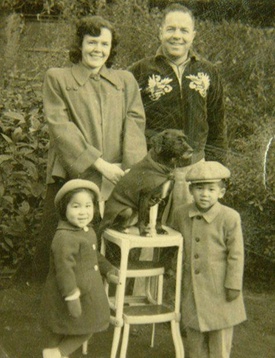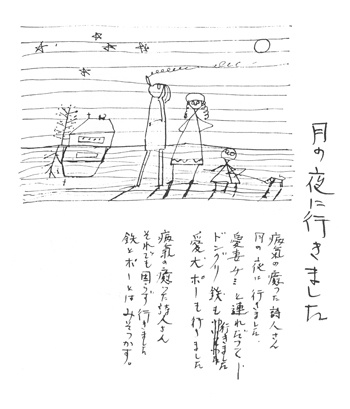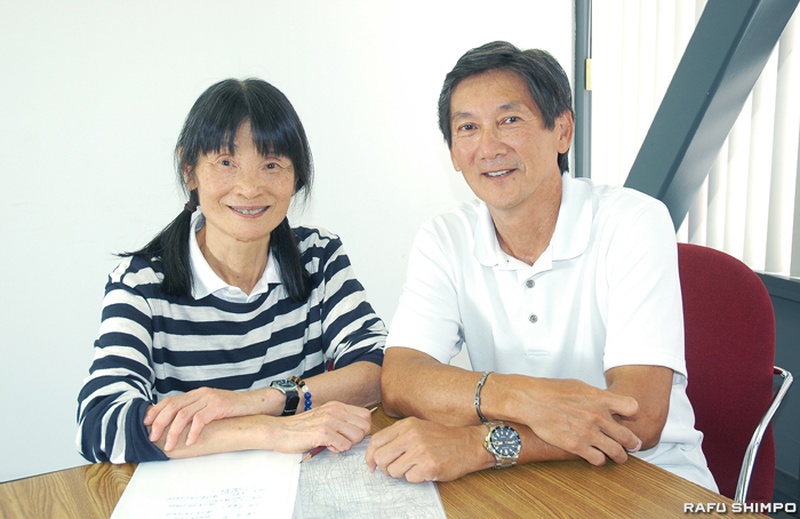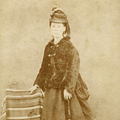After 30 years of searching, he meets his cousin, who was adopted to the U.S. after the war and moved to Torrance.
"What if my fates and Tetsu's had been reversed? I would have had to live my whole life never knowing about my mom and dad. When I thought about it like that, it didn't seem like something that was happening to someone else." For 30 years, Shimamura Naoko, who lives in Kashiwa City, Chiba Prefecture, has been searching for her cousin Tetsu (Terry Weber, hereafter referred to as Terry), who lives in Torrance and is the son of her uncle, the late painter Shimamura Yojiro, who was adopted to the US at the age of three. Then last year, the two finally met, and this meeting brought about another miracle. This is the story of a family between Japan and the US, told in two parts. [Interviews by Yoshida Junko and Gwen Muranaka]
An encounter with a book
Naoko's uncle and Terry's biological father, Shimamura Yojiro, was an unknown painter in his lifetime. Born in Kagurazaka, Tokyo in 1916, he graduated from the former Prefectural Fourth Middle School (now Tokyo Metropolitan Toyama High School). After dropping out of the former Urawa High School (now Saitama University), he became a painter. In 1944, he traveled to China as a war painter, but returned to Japan after contracting tuberculosis. After that, he continued his creative work despite being in and out of hospital several times, but passed away in 1953 at the young age of 37.
What prompted Naoko to start researching Yojiro was her encounter with a book in 1984.
That day, Naoko stopped by the bookstore in the Matsudo station building on her way home from work to buy a book, as she usually does. She found the book she was looking for, and as she passed by a stack of books on her way to the cashier, her left hand suddenly reached for a book. On the cover was a picture of a girl in orange clothes. She picked it up and opened it, and at the beginning it read, "About Shimamura Yojiro."
"Oh, that's the same name as Uncle Hiroshi..." As I continued to read, I found the story I had heard from my parents, albeit in fragments. "But Uncle Hiroshi was unknown, and I had never heard of him as the kind of person who would be featured in a book..." I was still puzzled, but I bought the book and went home.
Later, when I called Naoko's father, Tadashige, Yojiro's younger brother, I learned that the author of the book, the late poet Eiji Usami, was Yojiro's close friend and had looked after him in his later years.
Naoko had only one painting that her father, Tadashige, had kept as one of Yojiro's belongings. However, she said she did not recognize the painting on the cover of the book as Yojiro's. "Looking back, I think I was called to by the painting. At the time, I didn't even know the name of the author, Usami."
As she read the book, Naoko began to want to know more about Yojiro. One day, when her relatives gathered together, Naoko asked about Yojiro. She felt the atmosphere in the room freeze over. "I realized that none of my relatives wanted to talk about Yojiro. So I decided that I had no choice but to find out for myself." Yojiro had become a painter despite his family's objections, which caused strained relationships with them.
In 1986, Naoko wrote to Usami, who was then a professor at Meiji University, and two months later she had the opportunity to hear about Yojiro from him. Usami had met Yojiro when they were students at the former First Higher School (now Hibiya High School), and they had become friends.
Usami gave him information about someone who had a painting by Yojiro, advised him to "look for the painting," and even lent him a self-portrait of Yojiro.
Searching for Terry
Naoko continued to hold exhibitions of Yojiro's posthumous works to let more people know about him. At the same time, she continued to search for Yojiro's son, Terry, who was born in June 1950 and adopted to the United States at the age of three. Terry was born about 20 days later than Naoko, and when he was a newborn, the two would sometimes sleep together on a zabuton cushion.
Yojiro had three children: two with his first wife, Kou, and Terry, his second wife, Kimiko (maiden name Tazawa).
Yojiro was repeatedly admitted to and discharged from hospital due to tuberculosis, and to prevent the infant from becoming infected, Terry was placed in the care of St. Odilia Home for Babies in Nakano Ward, Tokyo. Yojiro was released from the hospital for a time in 1951, but Kimiko had already left him.

On August 10, 1953, Terry was adopted by American military officers Joe and Esta Weber, and named Terry Eugene Weber. At the time, it was common for soldiers of the occupying forces to adopt children from orphanages.
Yojiro's love for Kimiko was deep, and his passion is apparent in the paintings he used her as a model. "His almost mad passion is conveyed through the paintings. The paintings he painted in pain after breaking up with Kimiko are different in style from his other works and are very memorable," says Naoko.
At the same time, his feelings for his son Terry, whom he is unable to meet, are also projected into the work.
The work, which is accompanied by the poem "He went on a moonlit night," is an imaginary depiction of Terry, who is no longer with Yojiro while he is battling illness.The work is filled with the deep love of a father and his secret thoughts of Terry from his hospital bed, as he is unable to see his son.

"If I were in Tetsu's (Terry's) position, with Asian features and an American father, I would want to know about his origins. So I wanted to at least tell Tetsu that his father was a wonderful artist," says Naoko.
Naoko began to seriously search for Terry in 1987. She tried various places, including an orphanage, a child consultation center in Suginami, and the US Embassy, and when she found out that his adoptive parents, Mr. and Mrs. Weber, had graduated from the University of Ottawa, she sent them a letter along with a collection of his art. But her efforts were in vain: "A year later I received a letter from the university saying that the Webers had already passed away and they could no longer be of any help to me."
"It's the DNA that does it."
In 2015, when all other options had been exhausted, a film about Yojiro's life was made and a screening was held. Naoko gave a gallery talk at the screening venue. "At that time, I had been searching for Tetsu (Terry) but just couldn't find him, so I asked the people at the venue how I could find him. They told me, 'The only way is through a family history .'"
Family History is an NHK program that interviews famous people on their behalf about their family history, looking at "identity" and "family ties." Naoko immediately wrote a letter to the program. As a result, although the program usually features famous people, Naoko was featured in the viewer's version.
Although she was unable to find him on her own, the program managed to track him down, and it turned out that he lived in Torrance. Naoko's home city of Kashiwa is a sister city of Torrance, and she felt a strange connection between the two.
After graduating from high school, Terry joined the Navy and served in the Vietnam War. After being discharged, he worked as an engineer for a parts manufacturer. He is now retired and lives in Torrance with his Japanese-American wife, Sharon. He also participated in the Nisei Week parade as a veteran. His eldest daughter, Lauren, was a court attendee at the 2010 Nisei Week parade. Furthermore, his eldest son, Mark, and Lauren, visited Kashiwa City as exchange students during their high school years as part of the sister city program.
The video showed Terry living a happy life with his two children and his first grandchild.
"The photo showed Terry surrounded by his family and doting on his newborn grandchild. It was a moment that made me feel glad to be living a happy life."
Even more surprising was that Terry had been good at drawing since he was a child. When the family found out that his father was a painter, they all agreed that it must be the work of DNA.
Ever since she began searching for Terry, Naoko has had the self-portrait of Yojiro that Usami had given her displayed in front of the telephone stand in the entrance hall. "I think it's important to display things. When you display them, you see them every day. Every time I pass by, my eyes meet with Yojiro's painting. I think that's why I was able to meet Tetsu (Terry)."
This time, Terry was able to meet his cousin Naoko, but this encounter brought about another miracle for the family.
*This article is reprinted from the February 28, 2018 edition of the Rafu Shimpo .
Read the English version of this story here. >>
© 2018 Yoshida Junko / The Rafu Shimpo








